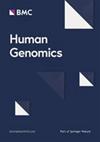从共享单倍型和等位基因推断土家族人的遗传历史和生物适应景观
IF 3.8
3区 医学
Q2 GENETICS & HEREDITY
引用次数: 0
摘要
来自代表性不足人群的高质量基因组数据集对于人群遗传分析和医学相关性至关重要。虽然土家族是中国西南部人口最多的少数民族,但以往的遗传学研究都很零散,只能部分揭示其遗传多样性景观。人们对土家族精细的遗传结构和潜在的生物适应性差异特征的了解仍处于起步阶段。本研究以长江流域中部地区的元土家族人群为研究对象,旨在探索土家族的人口历史和与自然选择相关的遗传结构。对元土家族进行的种群遗传分析表明,他们在东亚南北遗传系中处于中间位置。研究发现,土家族人与邻近的讲汉化语言的人群之间有着密切的遗传亲缘关系。混血模型表明,土家族可被视为北方和南方祖先的混血。对 f3/f4 统计量的估计证实了土家族祖先与古代黄河流域的粟农和与八盘秦岑有关的族群之间存在联系。此外,研究还探讨了特定种群的自然选择特征,发现了土家族和南方土著种群之间高度分化的功能变异,包括与毛发形态(如 EDAR)和皮肤色素沉着(如 SLC24A5)相关的基因。此外,在种族不同但地理位置相邻的人群中,还发现了共同和独特的选择特征,突显了他们的广泛混血以及这种混血所带来的生物适应性。该研究揭示了土家族和其他民族语言多样的东亚群体之间显著的人口迁移和遗传混杂,从当前的遗传景观中阐明了地理多样群体之间的差异化适应过程。本文章由计算机程序翻译,如有差异,请以英文原文为准。
Genetic history and biological adaptive landscape of the Tujia people inferred from shared haplotypes and alleles
High-quality genomic datasets from under-representative populations are essential for population genetic analysis and medical relevance. Although the Tujia are the most populous ethnic minority in southwestern China, previous genetic studies have been fragmented and only partially reveal their genetic diversity landscape. The understanding of their fine-scale genetic structure and potentially differentiated biological adaptive features remains nascent. This study aims to explore the demographic history and genetic architecture related to the natural selection of the Tujia people, focusing on a meta-Tujia population from the central regions of the Yangtze River Basin. Population genetic analyses conducted on the meta-Tujia people indicate that they occupy an intermediate position in the East Asian North-South genetic cline. A close genetic affinity was identified between the Tujia people and neighboring Sinitic-speaking populations. Admixture models suggest that the Tujia can be modeled as a mixture of northern and southern ancestries. Estimates of f3/f4 statistics confirmed the presence of ancestral links to ancient Yellow River Basin millet farmers and the BaBanQinCen-related groups. Furthermore, population-specific natural selection signatures were explored, revealing highly differentiated functional variants between the Tujia and southern indigenous populations, including genes associated with hair morphology (e.g., EDAR) and skin pigmentation (e.g., SLC24A5). Additionally, both shared and unique selection signatures were identified among ethnically diverse but geographically adjacent populations, highlighting their extensive admixture and the biological adaptations introduced by this admixture. The study unveils significant population movements and genetic admixture among the Tujia and other ethno-linguistically diverse East Asian groups, elucidating the differentiated adaptation processes across geographically diverse populations from the current genetic landscape.
求助全文
通过发布文献求助,成功后即可免费获取论文全文。
去求助
来源期刊

Human Genomics
GENETICS & HEREDITY-
CiteScore
6.00
自引率
2.20%
发文量
55
审稿时长
11 weeks
期刊介绍:
Human Genomics is a peer-reviewed, open access, online journal that focuses on the application of genomic analysis in all aspects of human health and disease, as well as genomic analysis of drug efficacy and safety, and comparative genomics.
Topics covered by the journal include, but are not limited to: pharmacogenomics, genome-wide association studies, genome-wide sequencing, exome sequencing, next-generation deep-sequencing, functional genomics, epigenomics, translational genomics, expression profiling, proteomics, bioinformatics, animal models, statistical genetics, genetic epidemiology, human population genetics and comparative genomics.
 求助内容:
求助内容: 应助结果提醒方式:
应助结果提醒方式:


